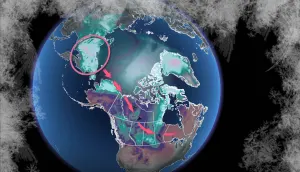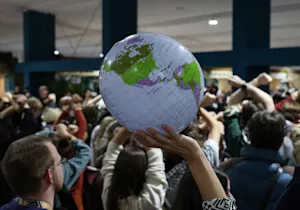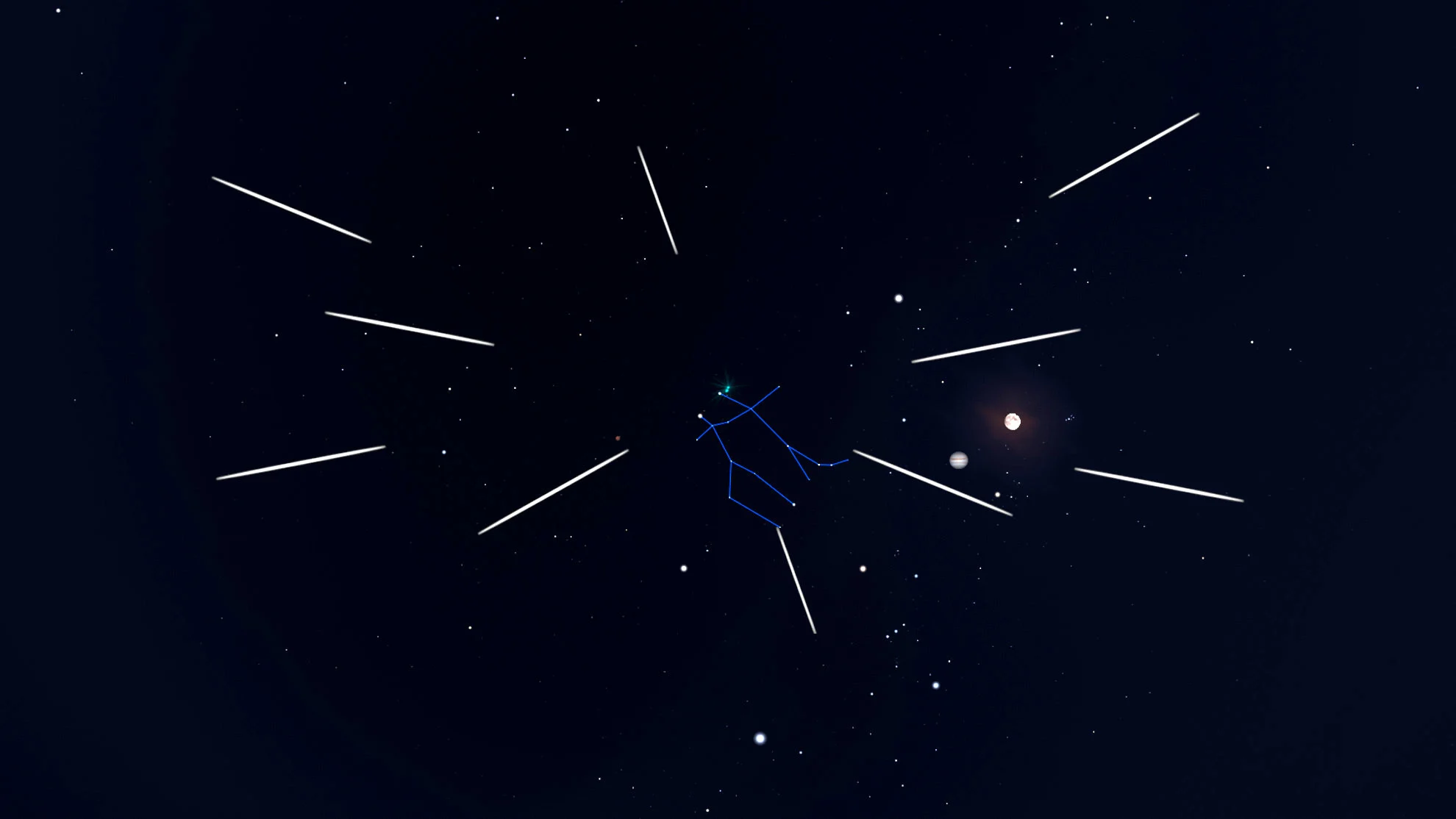
The Fall 'Season of Meteor Showers' may include rare astronomical treats
A possible bright comet, a southern hemisphere solar eclipse, and a half-dozen meteor showers (including one that might deliver a meteor storm!) — there's no shortage of things to see in the sky this Fall season.
As the nights grow longer and the weather cools off, Fall is a great time of year to get out to stargaze, especially since this could rightly be called The Season of Meteor Showers.
At 8:43 a.m. EDT on September 22, the Sun will pass over the celestial equator headed south. This will mark the 2024 autumnal equinox for the northern hemisphere, and the earliest one we’ve seen in 228 years.
The last September equinox that was close was 1896, when it occurred at 8:03 a.m. EST on the 22nd. However, Daylight Saving Time wasn't in use in 1896. To make a proper comparison, we need to subtract an hour ("fall back") from this year's timing — 8:43 a.m. EDT becomes 7:43 a.m. EST, which is even earlier than the timing of the 1896 equinox!
To find an earlier fall equinox than this year’s, we have to look all the way back to September 22, 1796. On that day, it occurred at 3:06 a.m. 'local mean time'.
With such an early start to the season, there's plenty to see, including what could be some rare treats.
Here is The Weather Network's guide to Fall 2024 astronomical events:
Sep 22: Fall Equinox
Sep 22~Oct 4: Comet C/2023 A3 (Tsuchinshan-ATLAS) in eastern predawn sky
Oct 1~14: Zodiacal Light before morning twilight
Oct 2: Annular Solar Eclipse. (South Pacific Ocean, Chile, Argentina)
Oct 5: Venus near the Crescent Moon (evening)
Oct 7: Draconid Meteor Shower peaks
Oct 10, onwards: Comet C/2023 A3 (Tsuchinshan-ATLAS) in western sky after sunset
Oct 16-17: Full Hunter's Supermoon (2024's Perigee Full Moon)
Oct 21-22: Orionid Meteor Shower peak
Nov 4: Venus near the Crescent Moon (evening)
Nov 5: Southern Taurid Meteor Shower peaks
Nov 11: Saturn near the Gibbous Moon
Nov 12: Northern Taurid Meteor Shower peaks
Nov 14: Potential Leonid meteor outburst
Nov 15-16: Full Beaver Supermoon
Nov 16-17: Leonid Meteor Shower peaks
Nov 17: Jupiter near the Gibbous Moon
Nov 20: Mars near the Gibbous Moon
Dec 4: Venus near the Crescent Moon (evening)
Dec 7-8: Jupiter at Opposition (brightest for 2024)
Dec 13-14: Geminid Meteor Shower peaks
Dec 14-15: Full Cold Moon
Dec 21: Winter Solstice
Visit our Complete Guide to Fall 2024 for an in depth look at the Fall Forecast, tips to plan for it and much more!
A Bright Comet?
For the first two weeks of Fall, we may be able to see a bright comet just above the eastern horizon before sunrise.
Comet C/2023 A3 (Tsuchinshan-ATLAS) was discovered in early 2023, and will be making its closest approach to the Sun on September 27, 2024. As it does so, it should be visible in the predawn sky, just above the eastern horizon, for roughly two weeks. It will likely require binoculars or a telescope to find it, and it will appear as a dim smudge against the backdrop of stars (better equipment will provide a better view, though).

These updated simulations of the night sky show Comet Tsuchinshan–ATLAS’s path through the sky (yellow line), morning by morning during its pass around the Sun (left) and then night by night after it emerges from evening twilight (right). (Stellarium/Scott Sutherland)
If the comet survives that close encounter with the Sun, it will emerge in the western sky just after sunset, in the second week of October. Afterwards, it will get higher and higher each night, and it will grow dimmer, as it gets farther away from the Sun. As with its first appearance, the comet is unlikely to be brightly visible to the unaided eye. Use a pair of binoculars or a telescope to spot it. Look between Venus and the bright star Arcturus to locate the comet in the sky.
Zodiacal Light
In early fall, sharp-eyed stargazers have a chance to spot the immense cloud of interplanetary dust that surrounds the Sun. This elusive phenomenon is known as the Zodiacal Light.
On any clear early morning during the first two weeks of October, observers that are under dark skies, far from urban light pollution, can turn their gaze to the eastern horizon, about 30 minutes before morning twilight begins. There, you may see a diffuse white glow in the shape of a triangle.
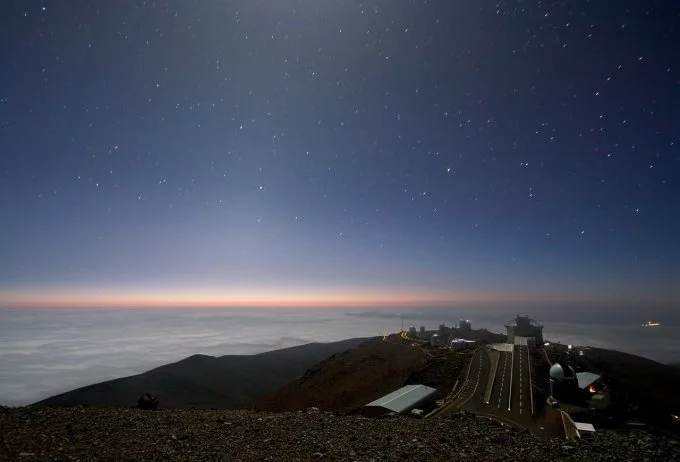
Moonlight and zodiacal light over La Silla. Credit: European Southern Observatory (ESO)
In the Royal Astronomical Society of Canada's 2021 Observer's Handbook, Dr. Roy Bishop, Emeritus Professor of Physics from Acadia University, wrote: "The zodiacal light appears as a huge, softly radiant pyramid of white light with its base near the horizon, and its axis centred on the zodiac (or better, the ecliptic). In its brightest parts, it exceeds the luminance of the central Milky Way."
The zodiacal light results from sunlight glinting off grains of dust that orbit the Sun in an immense disk. This is only visible at certain times of the year. In February and March, it shows up in the western sky after sunset, for roughly two weeks after a Full Moon. In September and October, it appears in the eastern sky before sunrise, for about two weeks following a New Moon.
According to Dr. Bishop, the zodiacal light can appear quite bright. However, viewers can still miss it due to urban light pollution. Also, due to inexperience, they can think that they missed it by mistakenly believing they are just seeing the glow of twilight.
READ MORE: Mars dust storms may be the source of 'zodiacal light' seen from Earth
The Moon
We see a total of three Full Moons during the Fall 2024 season.
The first of those, which rises on the night of October 16, is the Hunter's Supermoon. This will be the ‘perigee’ Full Moon — the ‘superest’ of this year’s supermoons, so to speak, making it the biggest and brightest Full Moon of 2024.

The November 15-16 Beaver Moon is the season's second supermoon. After which we will see a more 'typical' Full Cold Moon, unfortunately timed on the night of December 14-15 (read on for the reason why).
DON'T MISS: What is the mysterious Moon Illusion?
Annular solar eclipse
However, before any of those Full Moons, be sure to mark the October 2 New Moon on your calendar. On that day, it will align perfectly with the Sun and Earth to produce 2024’s second spectacular solar eclipse.
This won’t be a total solar eclipse, as we witnessed back on April 8. Due to this New Moon occurring farther away from Earth than the April New Moon, it will not completely block the Sun’s disk during the event. Instead, it will only block most of the disk, leaving a thin ring around it, resulting in an ‘annular’ or ‘ring of fire’ solar eclipse.

This image of the May 21, 2012 annular solar eclipse was taken from Tokyo, Japan. Credit: Nakae/Wikimedia Commons (CC-BY-2.0)
The full 'ring of fire' will be visible to anyone along the path of annularity.
This path starts in the equatorial Pacific Ocean and stretches to the southeast, across Easter Island, southern regions of Chile and Argentina, just north of the Falkland Islands, before ending in the south Atlantic Ocean.
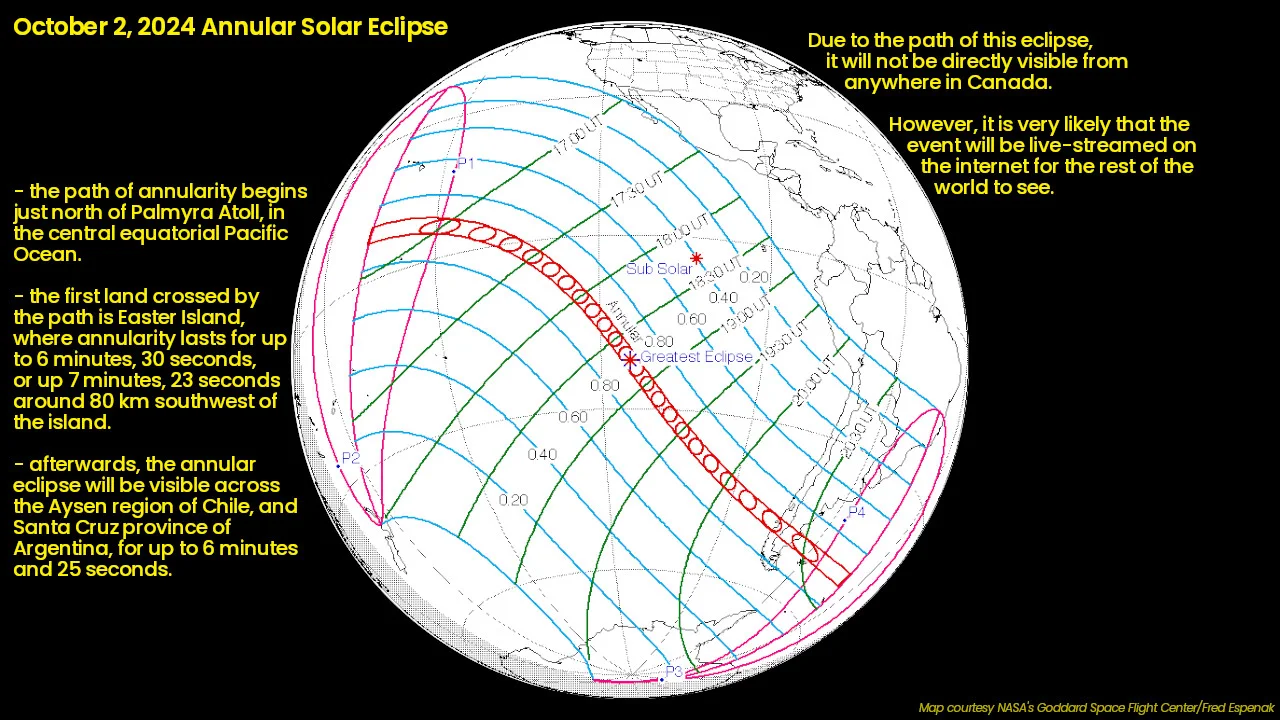
This solar eclipse will not be directly visible to anyone in Canada. However, it will undoubtedly be streamed online by observers on that day, so check back for more details leading up to the eclipse.
The Planets
Right off the start of the season, four bright planets will dominate the sky throughout the night.
On the night of the Fall Equinox, Saturn will rise in the east as the Sun is setting in the west. Turn around to the western horizon to spot Venus just above the horizon at that time. Jupiter will follow around 11 p.m. local time, and Mars will crest the horizon about 90 minutes later. Each will then rise a little bit earlier each night, as the season progresses.
If you look closely, you may notice that Saturn grows dimmer night by night. This is not only due to Earth getting farther away from the ringed planet, but also because Saturn’s rings are in the process of vanishing — not permanently, mind you! On March 23, 2025, we will experience a 'ring-crossing event' and only see the planet’s rings edge-on (they’re over 280,000 km across, but only about 1 km thick!).
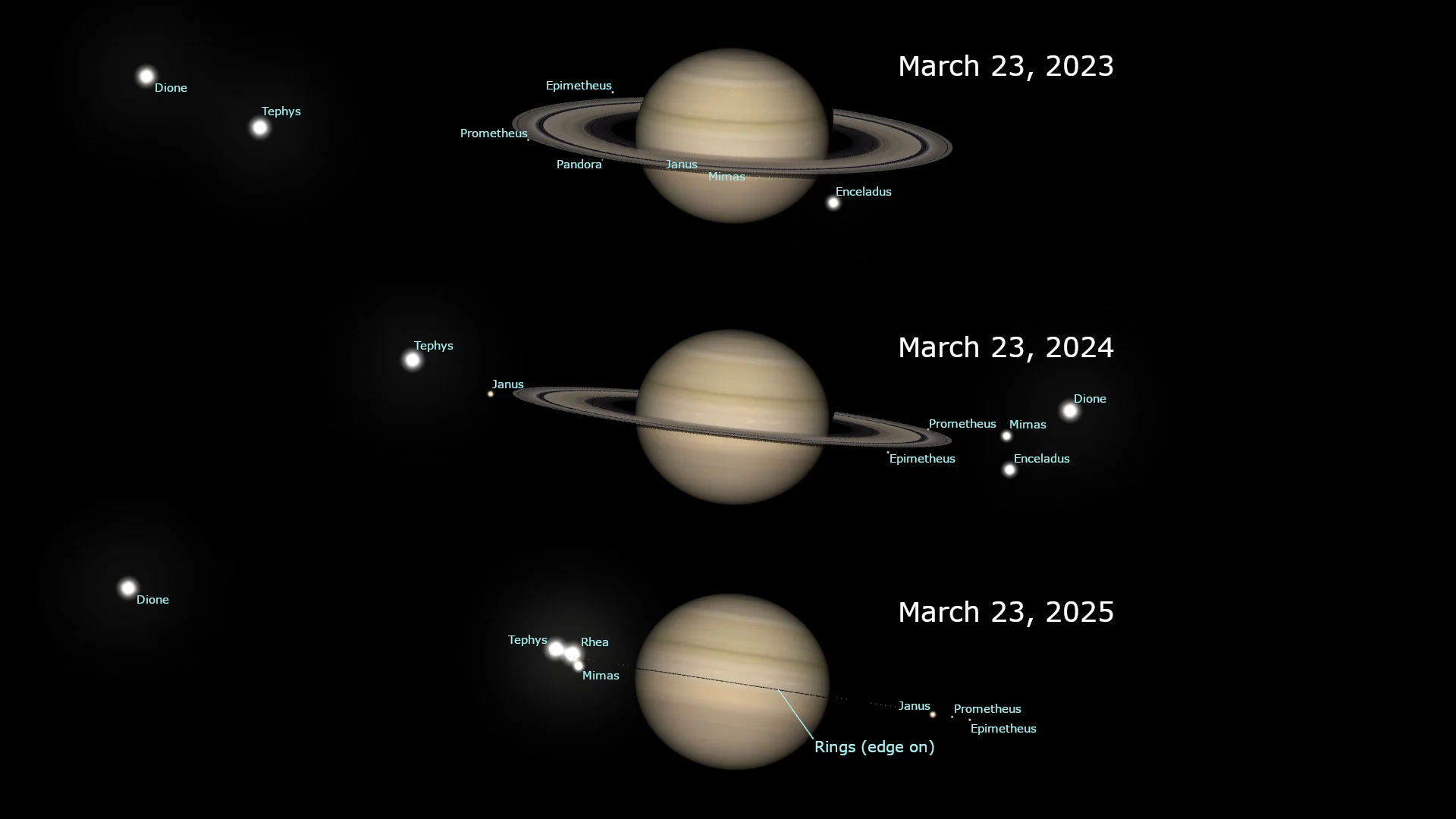
These simulated views of Saturn show the planet as seen from Earth's northern hemisphere in March of 2023, 2024 and 2025. (Stellarium/Scott Sutherland)
Conversely, Venus, Jupiter, and Mars will both grow brighter on a nightly basis.
Venus will remain the ‘evening star’ throughout the entire season, visible just above the western horizon after sunset, and getting brighter as it gets closer and closer to us. Look for it near the thin Crescent Moon on the nights of October 5, November 4, and December 4.
Jupiter will reach its maximum brightness for this year on the night of December 7, when we reach Opposition — the point when Earth is directly between the Sun and the immense gas giant planet.
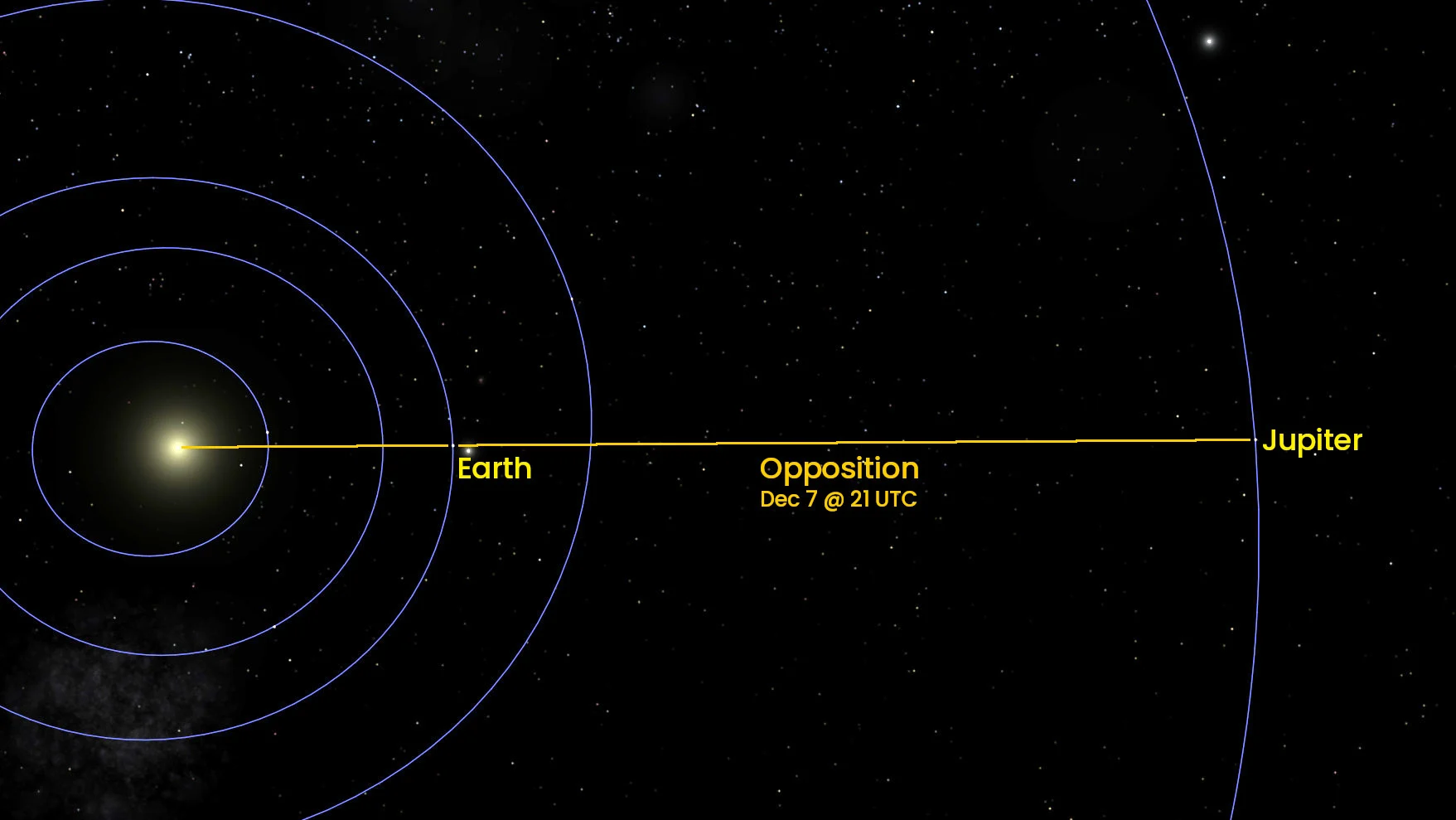
The alignment of the Sun, Earth, and Jupiter, on December 7, 2024 (Celestia/Scott Sutherland)
Mars, on the other hand, will continue to grow brighter right through into winter, ahead of its closest approach to Earth in mid-January 2025.
Mercury is too close to the Sun at the start of the season, but will emerge from evening twilight very briefly, potentially visible above the western horizon, in mid-November.
__READ MORE: Saturn's rings will 'disappear' by early-2025
The Season of Meteor Showers
While there’s a chance you may spot a random meteor flash by overhead on any night of the year, there are certain times when concentrations of them emerge from specific points in the night sky. These are meteor showers, with the concentrations of meteors originating from different streams of comet or asteroid debris that Earth passes through as we orbit the Sun.
Astronomers track roughly three dozen meteor showers every year, but only around 12 or so tend to be significant enough to watch. Of those 12, half occur during the Fall season. In fact, there’s not a single night from Fall Equinox to Winter Solstice without at least one meteor shower active at the time.

Even with multiple overlapping meteor showers going on throughout the season, there are very specific nights that are best for viewing each individual shower. These nights are when Earth passes through the densest part of a particular debris stream, resulting in the greatest number of meteors from that shower.
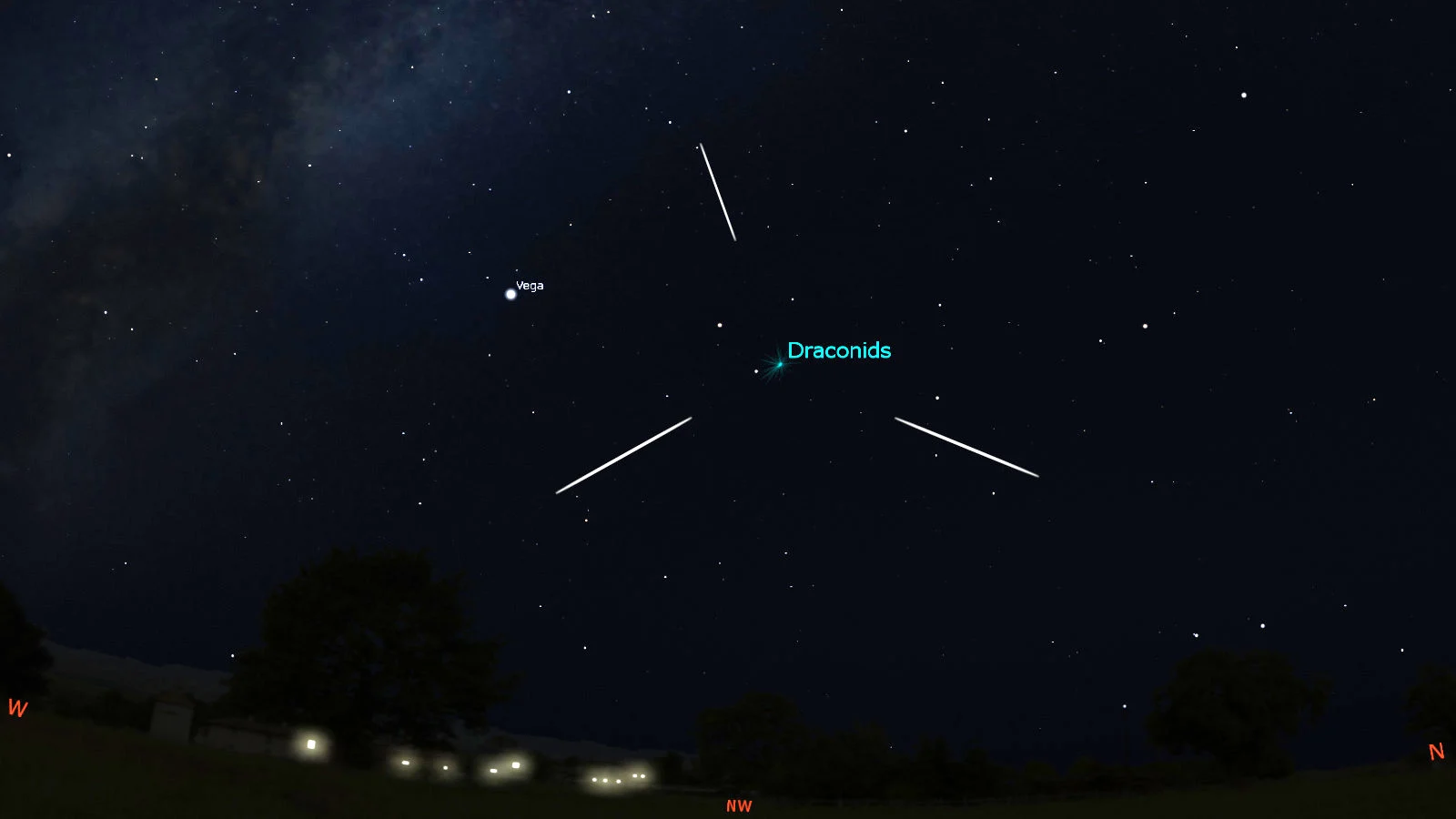
The night sky during the peak of the Draconid meteor shower on October 7-8, 2024. (Stellarium/Scott Sutherland)
The Draconids are the first to peak. This is one of the shortest meteor showers of the year, lasting only 5 nights, from October 6-10. It only delivers a handful of meteors each night, except during its peaks on the night of Oct. 7-8 in 2024, when it typically produces between 5-10 meteors every hour.
Although it is usually fairly weak compared to other meteor showers, rare outbursts from the Draconids have put on some of the most spectacular meteor displays of the 20th century!
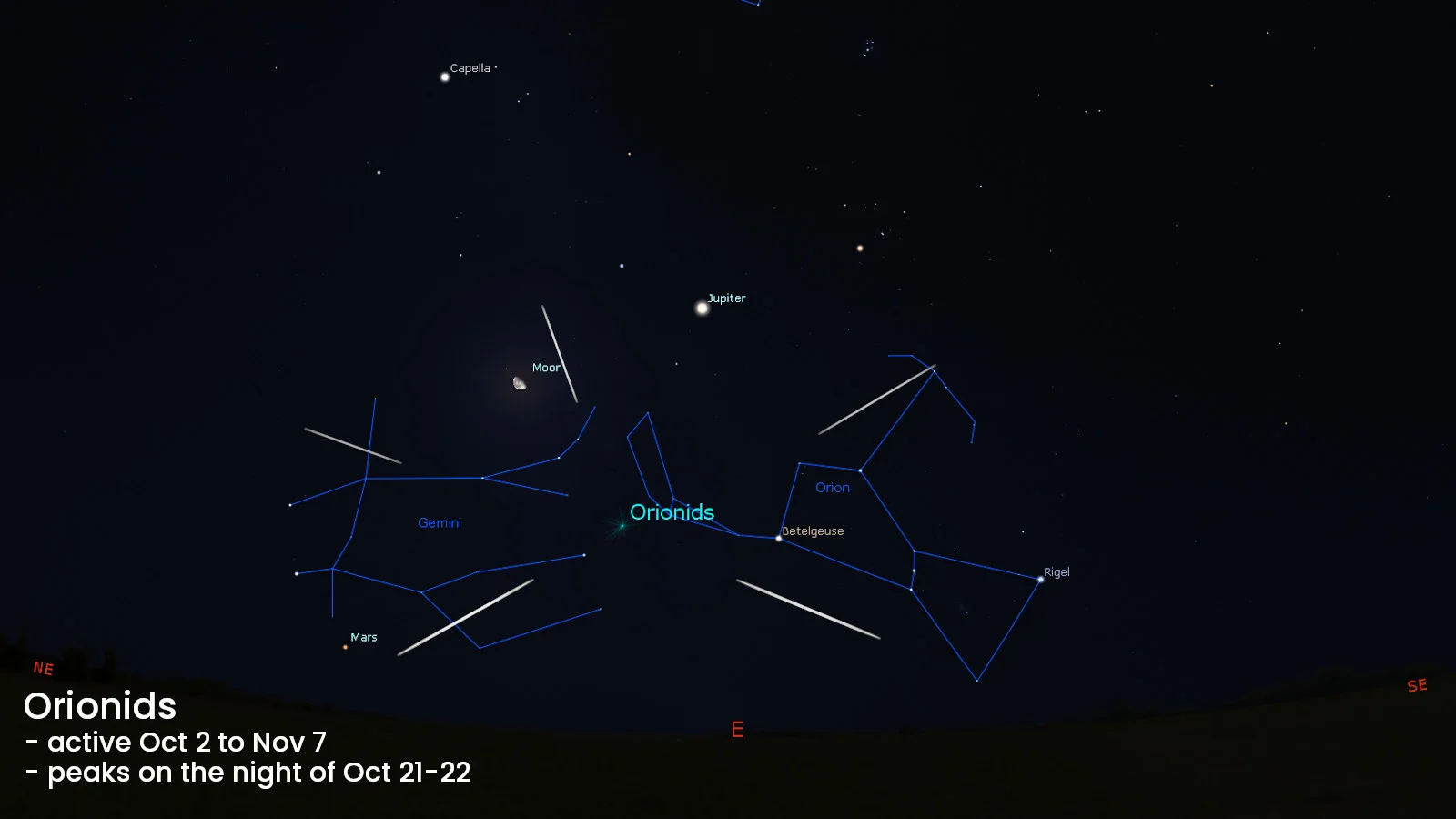
The best viewing for the Orionid meteor shower will be in the hours before sunrise on Oct 21, 2024. (Stellarium/Scott Sutherland)
The Orionids are next. This is the second of two annual meteor showers that we get from Halley's Comet.
You may only see one or two Orionids per hour in October and early November. During its peak, though, which occurs on the night of October 21-22 in 2024, it is expected to produce around 20 meteors per hour. The shower begins around 10:00 p.m., local time, on that night, and continues until daybreak.

The radiants of the Taurid meteor showers are positioned very close together in the sky each Fall. (Stellarium/Scott Sutherland)
After the Orionids come the twin meteor showers — the southern and northern Taurids. Long ago, this was probably a single meteor shower, originating from a large comet. That comet has since shattered, with two of the fragments producing the Taurid meteor showers — asteroid 2004 TG10 for the northern Taurids and Comet 2P/Encke for the southern Taurids.
This year, the Southern Taurids are expected to peak on November 5, and the Northern Taurids should reach their peak on November 12.
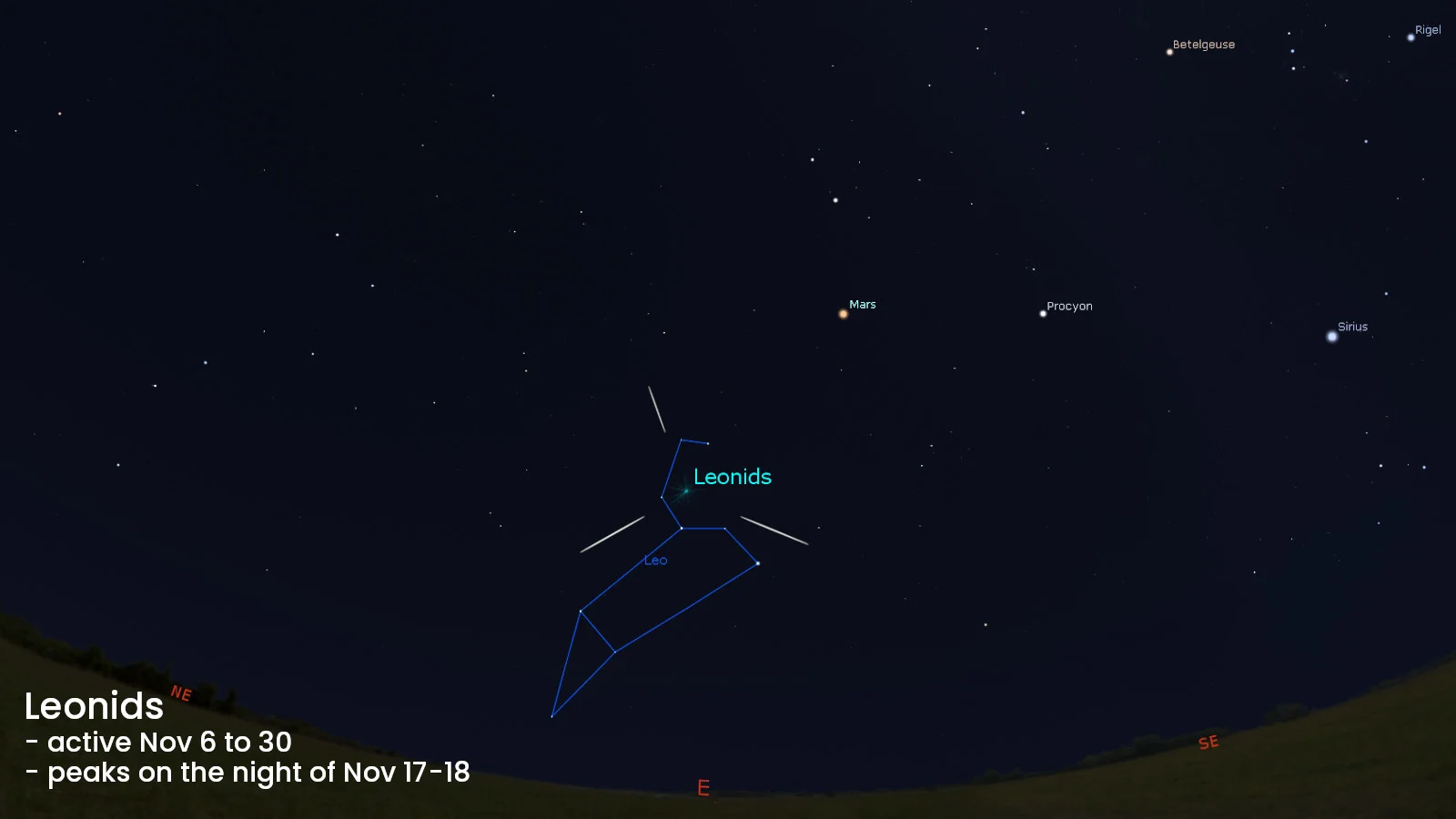
Leonid meteors appear to radiate outward from within the constellation Leo during the November 16-17 peak. (Stellarium/Scott Sutherland)
The Leonids is another relatively weak meteor shower, which reaches its peak on the night of November 16-17. This year, it is expected to produce between 15-20 meteors per hour on that night.
However, according to the International Meteor Organization, it may give us an even better show a few nights before the peak. On November 14, Earth is predicted to pass through a trail of debris from Comet Tempel-Tuttle — the same trail that produced a meteor storm back in 2001, when thousands of meteors were reported throughout the night.
Find a dark place to observe from in the early pre-dawn hours of November 14, and then again that night. There’s no guarantee that anything significant will occur, but it’s still worth a try to see such an exceptional event.
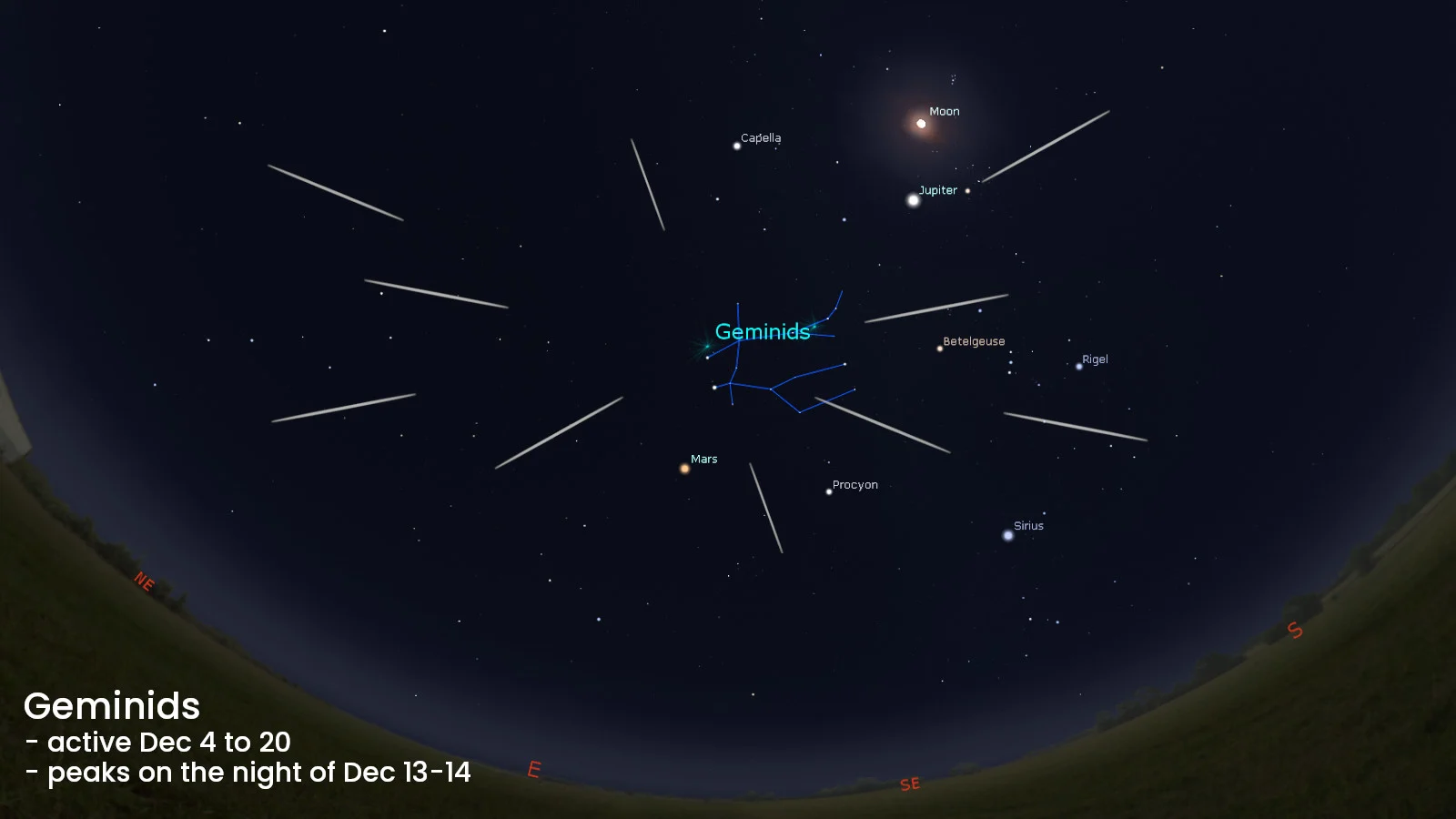
The radiant of the Geminid meteor shower is in the eastern sky during its peak on the night of Dec. 13-14, 2024. (Stellarium/Scott Sutherland)
Finally, one of the three best meteor showers of the year comes around towards the end of Fall.
The Geminid meteor shower, which originates from 'rock comet' asteroid 3200 Phaethon, occurs from December 4 to December 20, and reaches its peak on the night of the 13th to the 14th.
The Geminids consistently deliver a spectacular show with reasonably bright and sometimes multicoloured meteors. During the night of the peak, it can deliver up to 100 or more per hour. Only bad weather or a bright moon (or both) tends to spoil the show.
There’s no telling what the weather will be like on that night, this far out. However, the peak occurs just one night before the December Full Moon. While that won’t necessarily cancel the show, we will see fewer visible meteors during the event, as the light from the Moon washes out the dimmer ones.
ESSENTIAL READING: How to get the most out of meteor showers and other night sky events
Winter Solstice
At 4:21 a.m. EST, on December 21, the Sun will reach its lowest point in the northern sky, pausing for a moment to mark the Winter Solstice.
This will not only be the Northern Hemisphere’s shortest day and longest night for 2024, it will also be the earliest Winter Solstice in more than 2 centuries!
Ever since we skipped the year 2000 as a leap year, every four years after, our equinoxes and solstices have set new records for being the earliest we’ve seen in a long time. In 2024, the Spring Equinox was the earliest since 1896. Due to our use of Daylight Saving Time, the Summer Solstice and Fall Equinox were the earliest since 1796.
On December 21, we’ll have the earliest winter solstice since 1797.
The records won't end here, though. The equinoxes and solstices will advance in time by roughly six hours each year for the next three years. Then, when the leap year of 2028 rolls around, they’ll slip back to being even earlier than they are now. And this pattern of earlier equinoxes and solstices every fourth year will continue, right up to 2096, before the timing resets when we have the leap year in 2100.







